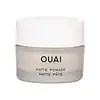Ouai Matte Pomade Versus Ouai Anti-Frizz Creme
What's inside
What's inside
 Key Ingredients
Key Ingredients

 Benefits
Benefits

 Concerns
Concerns

 Ingredients Side-by-side
Ingredients Side-by-side

Petrolatum
EmollientKaolin
AbrasivePEG-7 Glyceryl Cocoate
EmulsifyingHydrogenated Soybean Oil
EmollientParaffin
PerfumingParaffinum Liquidum
EmollientParfum
MaskingSynthetic Beeswax
Emulsion StabilisingMicrocrystalline Wax
Emulsion StabilisingBHT
AntioxidantBenzyl Benzoate
AntimicrobialBenzyl Salicylate
PerfumingCitronellol
PerfumingLinalool
PerfumingStearic Acid
CleansingHexyl Cinnamal
PerfumingHydroxycitronellal
PerfumingGeraniol
PerfumingWater
Skin ConditioningC13-15 Alkane
SolventEthylhexyl Olivate
Skin ConditioningPolyacrylate-13
Glycerin
HumectantSqualane
EmollientBrassica Campestris/Aleurites Fordi Oil Copolymer
Skin ConditioningBeta Vulgaris Root Extract
Skin ConditioningArtocarpus Heterophyllus Fruit Extract
Skin ConditioningTocopherol
AntioxidantDimethicone
EmollientCetearyl Alcohol
EmollientArginine
MaskingPolysorbate 20
EmulsifyingSorbitan Isostearate
EmulsifyingEthylhexylglycerin
Skin ConditioningCaprylic/Capric Triglyceride
MaskingPolyisobutene
Lactobacillus Ferment
Skin ConditioningParfum
MaskingTrisodium Ethylenediamine Disuccinate
Phenoxyethanol
PreservativeCitric Acid
BufferingLimonene
PerfumingAlpha-Isomethyl Ionone
PerfumingGeraniol
PerfumingHydroxycitronellal
PerfumingLinalool
PerfumingCitronellol
PerfumingCinnamyl Alcohol
PerfumingWater, C13-15 Alkane, Ethylhexyl Olivate, Polyacrylate-13, Glycerin, Squalane, Brassica Campestris/Aleurites Fordi Oil Copolymer, Beta Vulgaris Root Extract, Artocarpus Heterophyllus Fruit Extract, Tocopherol, Dimethicone, Cetearyl Alcohol, Arginine, Polysorbate 20, Sorbitan Isostearate, Ethylhexylglycerin, Caprylic/Capric Triglyceride, Polyisobutene, Lactobacillus Ferment, Parfum, Trisodium Ethylenediamine Disuccinate, Phenoxyethanol, Citric Acid, Limonene, Alpha-Isomethyl Ionone, Geraniol, Hydroxycitronellal, Linalool, Citronellol, Cinnamyl Alcohol
 Reviews
Reviews

Ingredients Explained
These ingredients are found in both products.
Ingredients higher up in an ingredient list are typically present in a larger amount.
Citronellol is used to add fragrance/parfum to a product. It is often derived from plants such as roses. In fact, it can be found in many essential oils including geranium, lavender, neroli, and more. The scent of Citronellol is often described as "fresh, grassy, and citrus-like".
Since the Citronellol molecule is already unstable, Citronellol becomes irritating on the skin when exposed to air.
Citronellol is a modified terpene. Terpenes are unsaturated hydrocarbons found in plants. They make up the primary part of essential oils.
Citronellol is not able to be absorbed into deeper layers of the skin. It has low permeability,
Citronellol is also a natural insect repellent.
Learn more about CitronellolGeraniol is used to add fragrance/parfum to a product. It is the main component of citronellol. It is a monoterpenoid and an alcohol.
Monoterpenes are naturally found in many parts of different plants.
Geraniol can be found in many essential oils including Rose Oil and Citronella Oil. The scent of Geraniol is often described as "rose-like". Many foods also contain Geraniol for fruit flavoring.
Geraniol can irritate the skin when exposed to air. However, irritation depends on the ability of geraniol to penetrate into the skin. In general, geraniol is not able to penetrate skin easily.
Geraniol is colorless and has low water-solubility. However, it is soluble in common organic solvents.
Like citronellol, it is a natural insect repellent.
2,6-Octadien-1-ol, 3,7-dimethyl-, (2E)-
Learn more about GeraniolHydroxycitronellal is a fragrance created from citronellal. The smell of hydroxycitronellal is often described as "citrus-like" or "melon-like".
Hydroxycitronellal is a known EU allergen and may cause irritation when applied to the skin.
Linalool is a fragrance and helps add scent to products. It's derived from common plants such as cinnamon, mint, citrus, and lavender.
Like Limonene, this ingredient oxidizes when exposed to air. Oxidized linalool can cause allergies and skin sensitivity.
This ingredient has a scent that is floral, spicy tropical, and citrus-like.
Learn more about LinaloolParfum is a catch-all term for an ingredient or more that is used to give a scent to products.
Also called "fragrance", this ingredient can be a blend of hundreds of chemicals or plant oils. This means every product with "fragrance" or "parfum" in the ingredients list is a different mixture.
For instance, Habanolide is a proprietary trade name for a specific aroma chemical. When used as a fragrance ingredient in cosmetics, most aroma chemicals fall under the broad labeling category of “FRAGRANCE” or “PARFUM” according to EU and US regulations.
The term 'parfum' or 'fragrance' is not regulated in many countries. In many cases, it is up to the brand to define this term.
For instance, many brands choose to label themselves as "fragrance-free" because they are not using synthetic fragrances. However, their products may still contain ingredients such as essential oils that are considered a fragrance by INCI standards.
One example is Calendula flower extract. Calendula is an essential oil that still imparts a scent or 'fragrance'.
Depending on the blend, the ingredients in the mixture can cause allergies and sensitivities on the skin. Some ingredients that are known EU allergens include linalool and citronellol.
Parfum can also be used to mask or cover an unpleasant scent.
The bottom line is: not all fragrances/parfum/ingredients are created equally. If you are worried about fragrances, we recommend taking a closer look at an ingredient. And of course, we always recommend speaking with a professional.
Learn more about Parfum